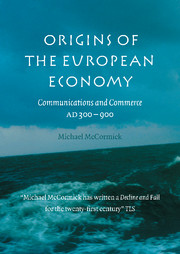Book contents
- Frontmatter
- Dedication
- Contents
- List of maps
- List of figures
- List of tables
- List of charts
- Preface
- List of abbreviations
- Commerce, communications, and the origins of the European economy
- PART I THE END OF THE WORLD
- 1 The end of the ancient world
- 2 Late Roman industry: case studies in decline
- 3 Land and river communications in late antiquity
- 4 Sea change in late antiquity
- The end of the ancient economy: a provisional balance sheet
- PART II PEOPLE ON THE MOVE
- PART III THINGS THAT TRAVELED
- PART IV THE PATTERNS OF CHANGE
- PART V COMMERCE
- Appendices
- Bibliography
- Index
1 - The end of the ancient world
from PART I - THE END OF THE WORLD
Published online by Cambridge University Press: 05 February 2015
- Frontmatter
- Dedication
- Contents
- List of maps
- List of figures
- List of tables
- List of charts
- Preface
- List of abbreviations
- Commerce, communications, and the origins of the European economy
- PART I THE END OF THE WORLD
- 1 The end of the ancient world
- 2 Late Roman industry: case studies in decline
- 3 Land and river communications in late antiquity
- 4 Sea change in late antiquity
- The end of the ancient economy: a provisional balance sheet
- PART II PEOPLE ON THE MOVE
- PART III THINGS THAT TRAVELED
- PART IV THE PATTERNS OF CHANGE
- PART V COMMERCE
- Appendices
- Bibliography
- Index
Summary
Daily I grow weaker from the pain, and I sigh longingly for the remedy of death. So much sickness of fevers has assaulted the clergy and people of this city that practically no free man, no slave remains who is good for any work or service. From the neighboring towns, the devastations of the epidemic are announced to us every day; how Africa is wasted by epidemic and fevers, you know more exactly, I suppose, for being closer to it. People arriving from the East describe worse desolations still. By all these things, as the end of the world draws near, you know that the affliction is general …
In August 599, Pope Gregory the Great found these comforting words about Rome and the rest of the empire to console a noble couple on their own sufferings in Sicily. Awareness of impending doom pervades his work. Epidemic, enemy invasion, riot, and economic dislocation encroached on his understanding of himself and his civilization. To an Anglo-Saxon king he announced climatic catastrophe: “As the end of the world approaches, many things menace us which never existed before: inversions of the climate, horrors from the heavens and storms contrary to the season, wars, famine, plagues, in some places earthquakes …”
Mere protestations of doom and gloom from a popular preacher bent on putting the fear of God into his wayward flock and terrorizing them into reform? Certainly not: Gregory believed it, and acted on his perception that the world was coming to an end.
- Type
- Chapter
- Information
- Origins of the European EconomyCommunications and Commerce AD 300–900, pp. 27 - 41Publisher: Cambridge University PressPrint publication year: 2002



